Dye Dale, O`neill Robert. The road to victory: From Pearl Harbor to Okinawa
Подождите немного. Документ загружается.

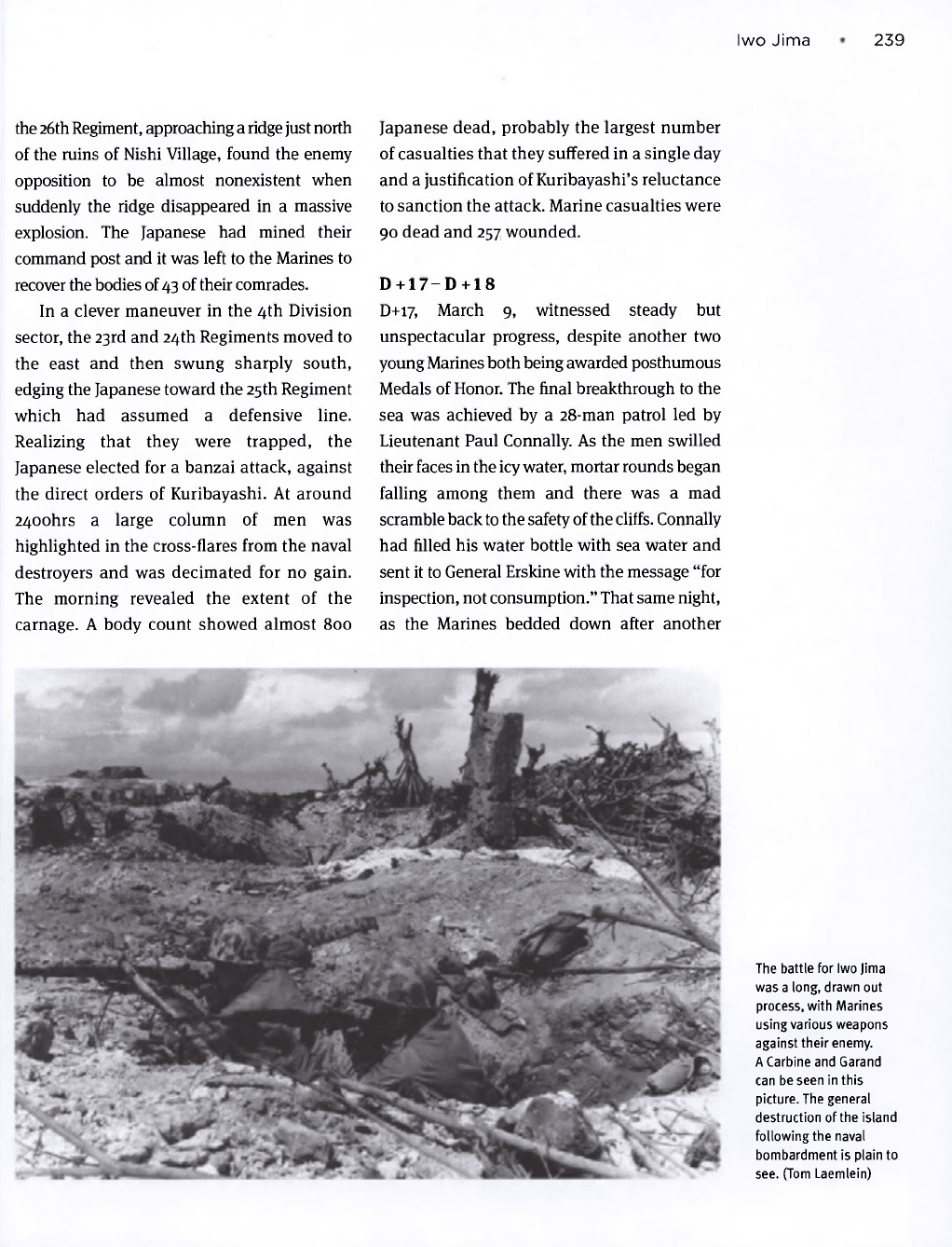
Iwo Jima •
239
the 26th Regiment, approaching a ridge just north
of the ruins of Nishi Village, found the enemy
opposition to be almost nonexistent when
suddenly the ridge disappeared in a massive
explosion. The Japanese had mined their
command post and it was left to the Marines to
recover the bodies of 43 of their comrades.
In a clever maneuver in the 4th Division
sector, the 23rd and 24th Regiments moved to
the east and then swung sharply south,
edging the Japanese toward the 25th Regiment
which had assumed a defensive line.
Realizing that they were trapped, the
Japanese elected for a banzai attack, against
the direct orders of Kuribayashi. At around
24oohrs a large column of men was
highlighted in the cross-flares from the naval
destroyers and was decimated for no gain.
The morning revealed the extent of the
carnage. A body count showed almost 800
Japanese dead, probably the largest number
of casualties that they suffered in a single day
and a justification of Kuribayashi's reluctance
to sanction the attack. Marine casualties were
90 dead and 257 wounded.
D+17-D+18
D+17, March 9, witnessed steady but
unspectacular progress, despite another two
young Marines both being awarded posthumous
Medals of Honor. The final breakthrough to the
sea was achieved by a 28-man patrol led by
Lieutenant Paul Connally. As the men swilled
their faces in the icy water, mortar rounds began
falling among them and there was a mad
scramble back to the safety of the
cliffs.
Connally
had filled his water bottle with sea water and
sent it to General Erskine with the message "for
inspection, not consumption." That same night,
as the Marines bedded down after another
The battle for Iwo Jima
was a long, drawn out
process, with Marines
using various weapons
against their enemy.
A Carbine and Garand
can be seen in this
picture. The general
destruction of the island
following the naval
bombardment is plain to
see. (Tom Laemlein)
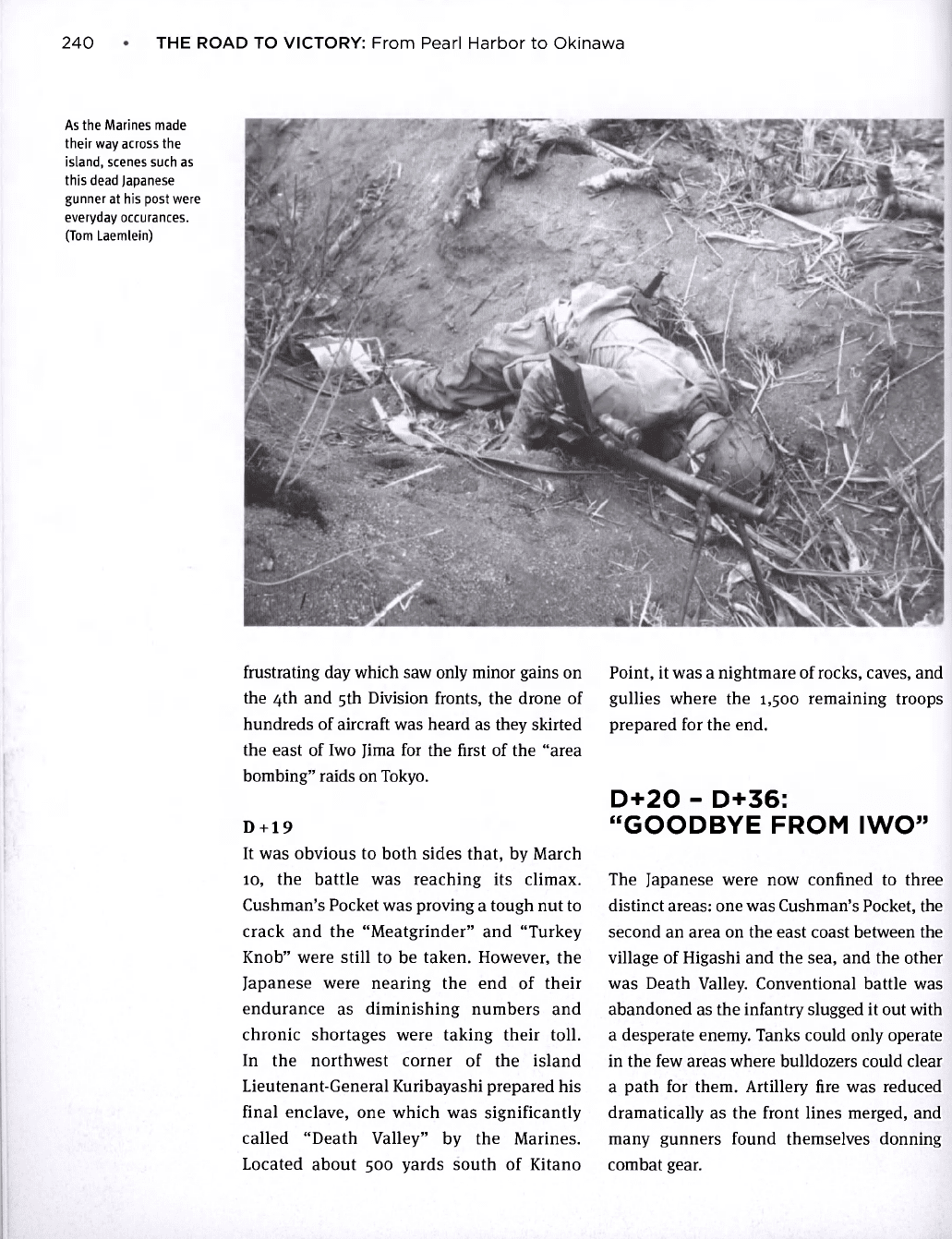
240 •
THE ROAD TO VICTORY: From Pearl Harbor to Okinawa
As the Marines made
their way across the
island, scenes such as
this dead Japanese
gunner at his post were
everyday occurances.
(Tom Laemlein)
frustrating day which saw only minor gains on
the 4th and 5th Division fronts, the drone of
hundreds of aircraft was heard as they skirted
the east of Iwo Jima for the first of the "area
bombing" raids on Tokyo.
D+19
It was obvious to both sides that, by March
10, the battle was reaching its climax.
Cushman's Pocket was proving a tough nut to
crack and the "Meatgrinder" and "Turkey
Knob" were still to be taken. However, the
Japanese were nearing the end of their
endurance as diminishing numbers and
chronic shortages were taking their toll.
In the northwest corner of the island
Lieutenant-General Kuribayashi prepared his
final enclave, one which was significantly
called "Death Valley" by the Marines.
Located about 500 yards south of Kitano
Point, it was a nightmare of rocks, caves, and
gullies where the 1,500 remaining troops
prepared for the end.
D+20 - D+36:
"GOODBYE FROM IWO"
The Japanese were now confined to three
distinct areas: one was Cushman's Pocket, the
second an area on the east coast between the
village of Higashi and the sea, and the other
was Death Valley. Conventional battle was
abandoned as the infantry slugged it out with
a desperate enemy. Tanks could only operate
in the few areas where bulldozers could clear
a path for them. Artillery fire was reduced
dramatically as the front lines merged, and
many gunners found themselves donning
combat gear.
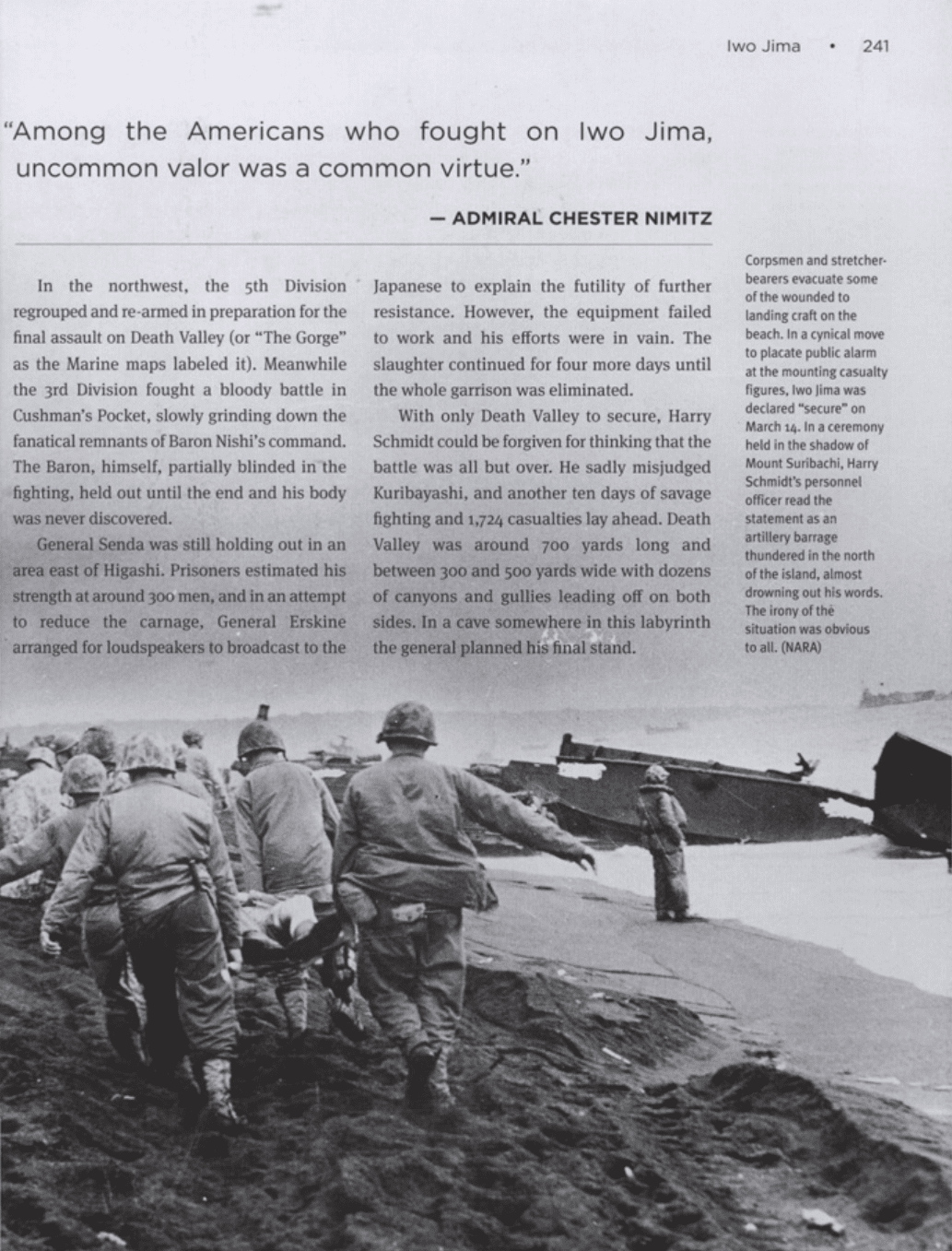
Iwo Jima • 241
Corpsmen and stretcher-
bearers evacuate some
of the wounded to
landing craft on the
beach. In a cynical move
to placate public alarm
at the mounting casualty
figures, Iwo Jima was
declared "secure" on
March 14. In a ceremony
held in the shadow of
Mount Suribachi, Harry
Schmidt's personnel
officer read the
statement as an
artillery barrage
thundered in the north
of the island, almost
drowning out his words.
The irony of the
situation was obvious
to all. (NARA)
"Among the Americans who fought on Iwo Jima,
uncommon valor was a common virtue."
- ADMIRAL CHESTER NIMITZ
Japanese to explain the futility of further
resistance. However, the equipment failed
to work and his efforts were in vain. The
slaughter continued for four more days until
the whole garrison was eliminated.
With only Death Valley to secure, Harry
Schmidt could be forgiven for thinking that the
battle was all but over. He sadly misjudged
Kuribayashi, and another ten days of savage
fighting and 1,724 casualties lay ahead. Death
Valley was around 700 yards long and
between 300 and 500 yards wide with dozens
of canyons and gullies leading off on both
sides. In a cave somewhere in this labyrinth
the general planned his final stand.
In the northwest, the 5th Division
regrouped and re-armed in preparation for the
final assault on Death Valley (or "The Gorge"
as the Marine maps labeled it). Meanwhile
the 3rd Division fought a bloody battle in
Cushman's Pocket, slowly grinding down the
fanatical remnants of Baron Nishi's command.
The Baron, himself, partially blinded in the
fighting, held out until the end and his body
was never discovered.
General Senda was still holding out in an
area east of Higashi. Prisoners estimated his
strength at around 300 men, and in an attempt
to reduce the carnage, General Erskine
arranged for loudspeakers to broadcast to the
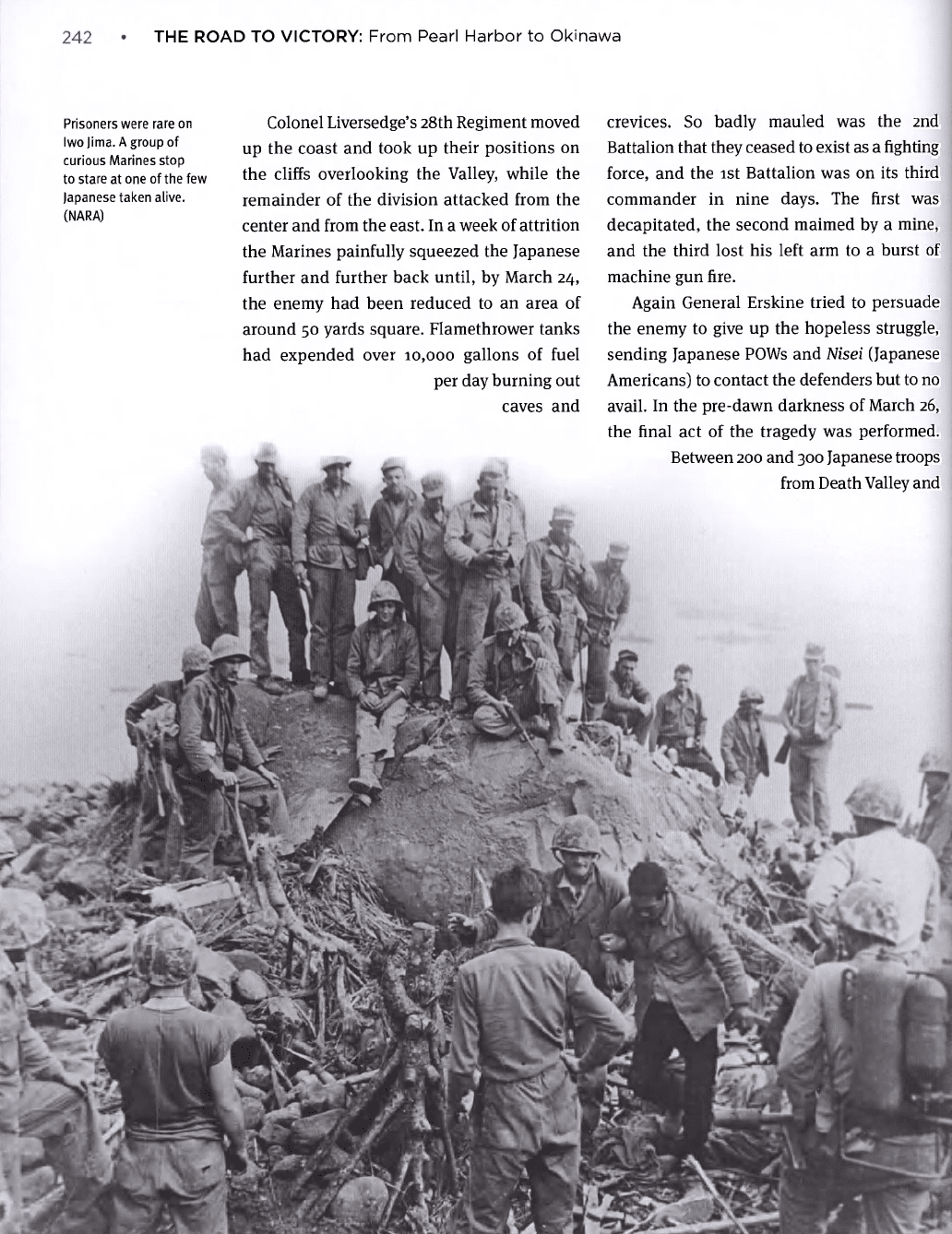
346 • THE ROAD TO VICTORY: From Pearl Harbor to Okinawa
Prisoners were rare on
Iwo Jima. A group of
curious Marines stop
to stare at one of the few
Japanese taken alive.
(NARA)
Colonel Liversedge's 28th Regiment moved
up the coast and took up their positions on
the cliffs overlooking the Valley, while the
remainder of the division attacked from the
center and from the east. In a week of attrition
the Marines painfully squeezed the Japanese
further and further back until, by March 24,
the enemy had been reduced to an area of
around 50 yards square. Flamethrower tanks
had expended over 10,000 gallons of fuel
per day burning out
caves and
crevices. So badly mauled was the 2nd
Battalion that they ceased to exist as a fighting
force, and the 1st Battalion was on its third
commander in nine days. The first was
decapitated, the second maimed by a mine,
and the third lost his left arm to a burst of
machine gun fire.
Again General Erskine tried to persuade
the enemy to give up the hopeless struggle,
sending Japanese POWs and Nisei (Japanese
Americans) to contact the defenders but to no
avail. In the pre-dawn darkness of March 26,
the final act of the tragedy was performed.
Between 200 and 300 Japanese troops
from Death Valley and
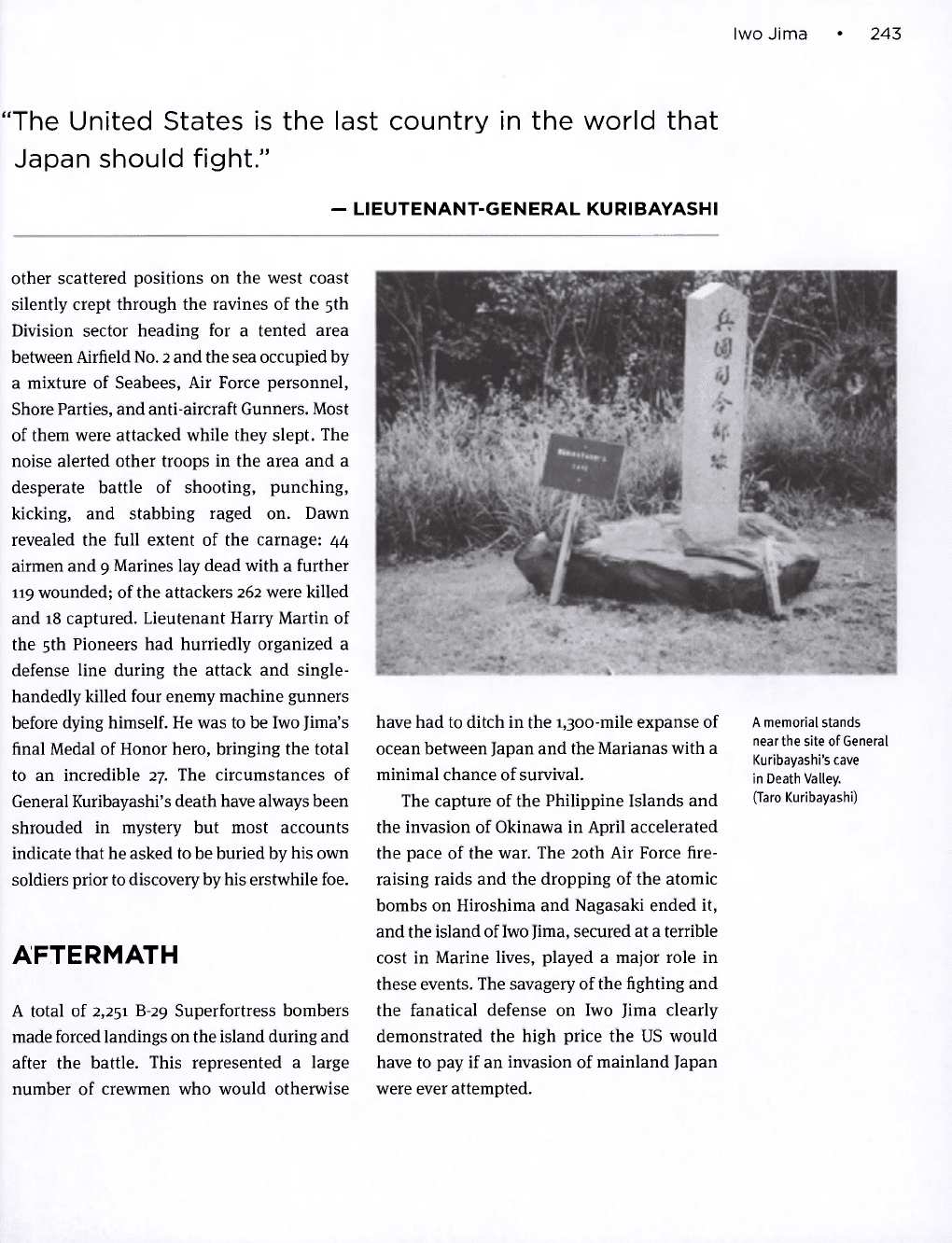
Iwo Jima • 243
"The United States is the last country in the world that
Japan should fight."
- LIEUTENANT-GENERAL KURIBAYASHI
other scattered positions on the west coast
silently crept through the ravines of the 5th
Division sector heading for a tented area
between Airfield No. 2 and the sea occupied by
a mixture of Seabees, Air Force personnel,
Shore Parties, and anti-aircraft Gunners. Most
of them were attacked while they slept. The
noise alerted other troops in the area and a
desperate battle of shooting, punching,
kicking, and stabbing raged on. Dawn
revealed the full extent of the carnage: 44
airmen and 9 Marines lay dead with a further
119 wounded; of the attackers 262 were killed
and 18 captured. Lieutenant Harry Martin of
the 5th Pioneers had hurriedly organized a
defense line during the attack and single-
handedly killed four enemy machine gunners
before dying himself. He was to be Iwo Jima's
final Medal of Honor hero, bringing the total
to an incredible 27. The circumstances of
General Kuribayashi's death have always been
shrouded in mystery but most accounts
indicate that he asked to be buried by his own
soldiers prior to discovery by his erstwhile foe.
AFTERMATH
A total of 2,251 B-29 Superfortress bombers
made forced landings on the island during and
after the battle. This represented a large
number of crewmen who would otherwise
have had to ditch in the 1,300-mile expanse of
ocean between Japan and the Marianas with a
minimal chance of survival.
The capture of the Philippine Islands and
the invasion of Okinawa in April accelerated
the pace of the war. The 20th Air Force fire-
raising raids and the dropping of the atomic
bombs on Hiroshima and Nagasaki ended it,
and the island of Iwo Jima, secured at a terrible
cost in Marine lives, played a major role in
these events. The savagery of the fighting and
the fanatical defense on Iwo Jima clearly
demonstrated the high price the US would
have to pay if an invasion of mainland Japan
were ever attempted.
A memorial stands
near the site of General
Kuribayashi's cave
in Death Valley.
(Taro Kuribayashi)
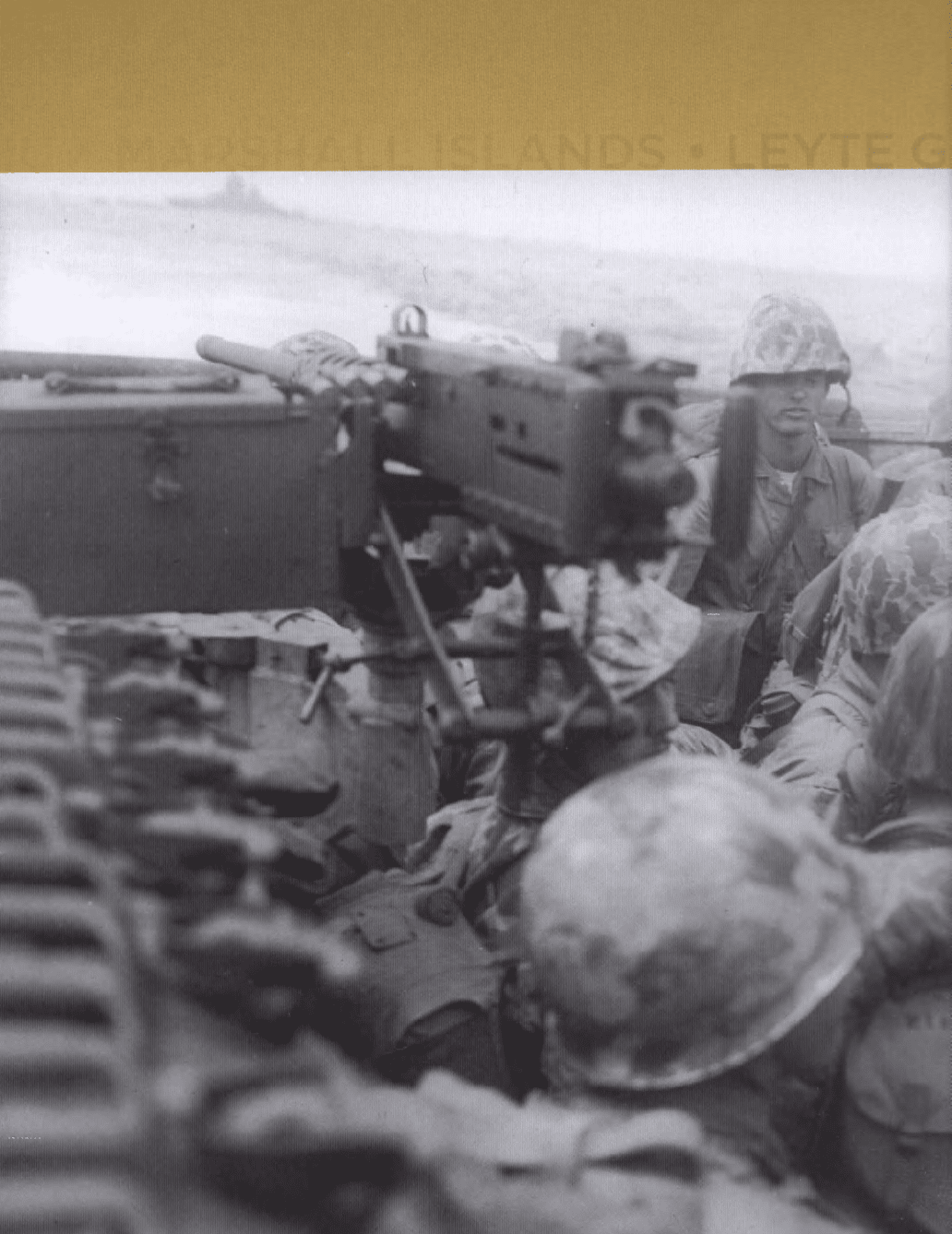
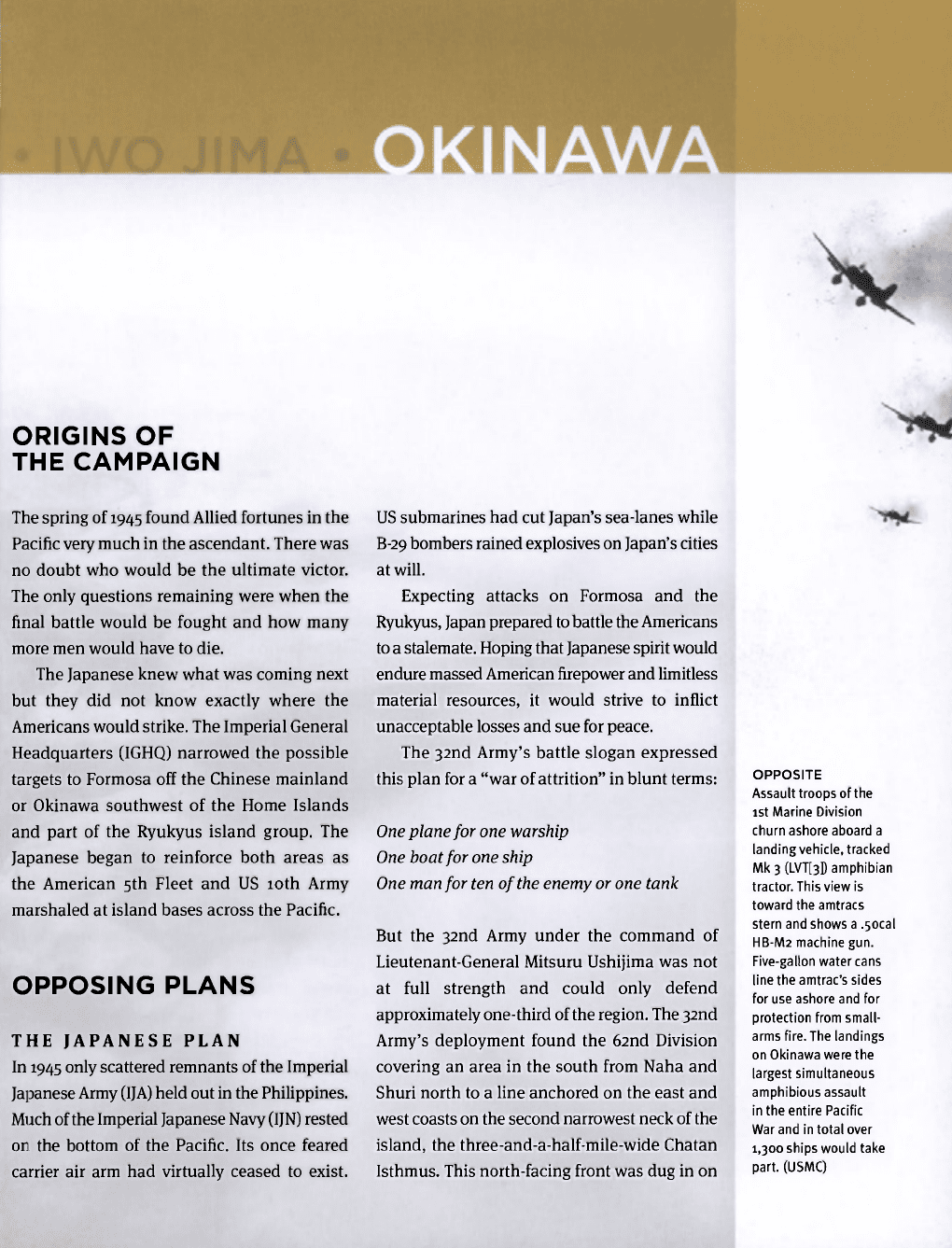
ORIGINS OF
THE CAMPAIGN
The spring of 1945 found Allied fortunes in the
Pacific very much in the ascendant. There was
no doubt who would be the ultimate victor.
The only questions remaining were when the
final battle would be fought and how many
more men would have to die.
The Japanese knew what was coming next
but they did not know exactly where the
Americans would strike. The Imperial General
Headquarters (IGHQ) narrowed the possible
targets to Formosa off the Chinese mainland
or Okinawa southwest of the Home Islands
and part of the Ryukyus island group. The
Japanese began to reinforce both areas as
the American 5th Fleet and US 10th Army
marshaled at island bases across the Pacific.
OPPOSING PLANS
THE JAPANESE PLAN
In 1945 only scattered remnants of the Imperial
Japanese Army (IJA) held out in the Philippines.
Much of
the
Imperial Japanese Navy (IJN) rested
on the bottom of the Pacific. Its once feared
carrier air arm had virtually ceased to exist.
US submarines had cut Japan's sea-lanes while
B-29 bombers rained explosives on Japan's cities
at will.
Expecting attacks on Formosa and the
Ryukyus, Japan prepared to battle the Americans
to a stalemate. Hoping that Japanese spirit would
endure massed American firepower and limitless
material resources, it would strive to inflict
unacceptable losses and sue for peace.
The 32nd Army's battle slogan expressed
this plan for a "war of attrition" in blunt terms:
One plane for one warship
One boat for one ship
One man for ten of the enemy or one tank
But the 32nd Army under the command of
Lieutenant-General Mitsuru Ushijima was not
at full strength and could only defend
approximately one-third of the region. The 32nd
Army's deployment found the 62nd Division
covering an area in the south from Naha and
Shuri north to a line anchored on the east and
west coasts on the second narrowest neck of the
island, the three-and-a-half-mile-wide Chatan
Isthmus. This north-facing front was dug in on
OPPOSITE
Assault troops of the
1st Marine Division
churn ashore aboard a
landing vehicle, tracked
Mk 3 (LVT[3B amphibian
tractor. This view is
toward the amtracs
stern and shows a .socal
HB-M2 machine gun.
Five-gallon water cans
line the amtrac's sides
for use ashore and for
protection from small-
arms fire. The landings
on Okinawa were the
largest simultaneous
amphibious assault
in the entire Pacific
War and in total over
1,300 ships would take
part. (USMC)
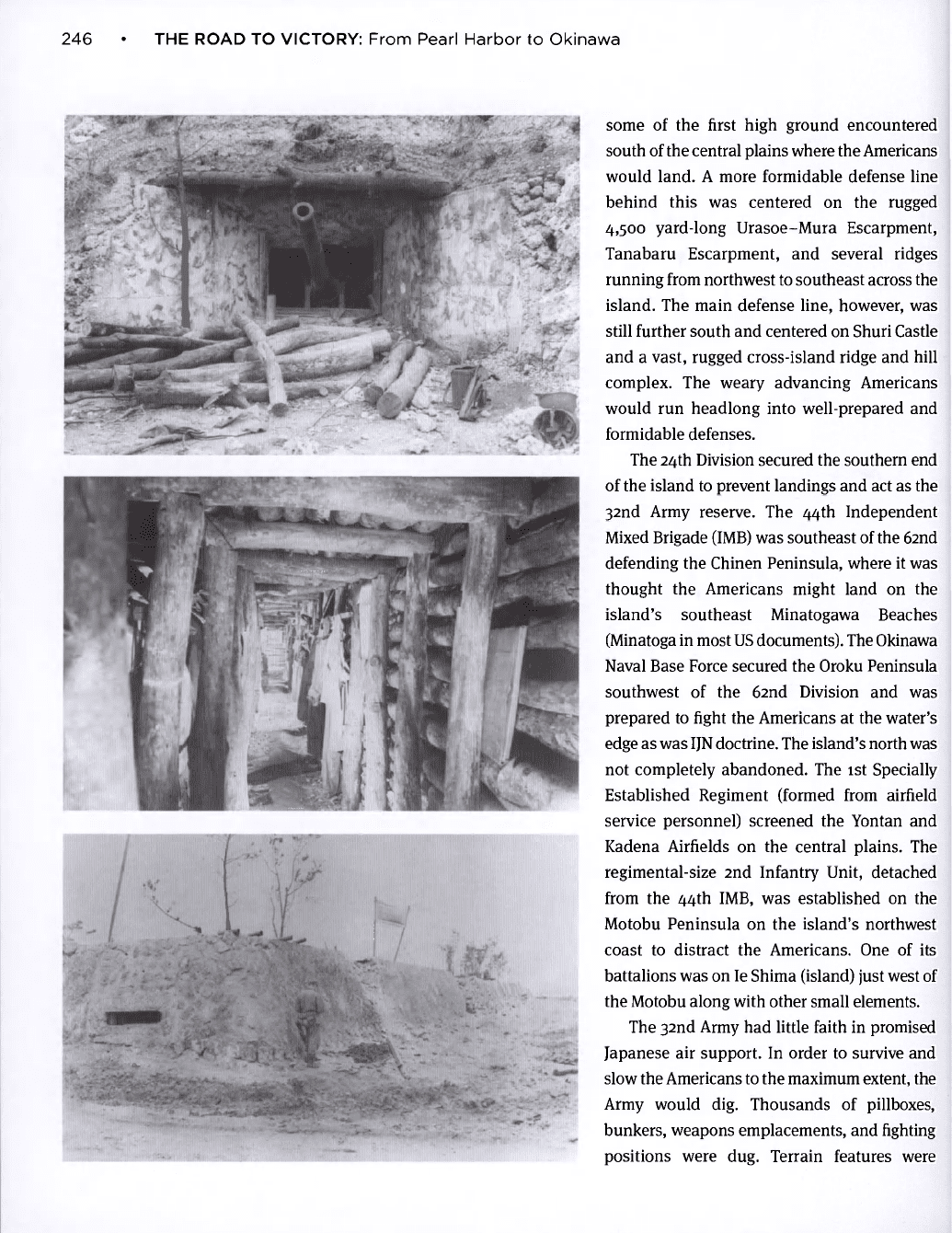
246 • THE ROAD TO VICTORY: From Pearl Harbor to Okinawa
some of the first high ground encountered
south of the central plains where the Americans
would land. A more formidable defense line
behind this was centered on the rugged
4,500 yard-long Urasoe-Mura Escarpment,
Tanabaru Escarpment, and several ridges
running from northwest to southeast across the
island. The main defense line, however, was
still further south and centered on Shuri Castle
and a vast, rugged cross-island ridge and hill
complex. The weary advancing Americans
would run headlong into well-prepared and
formidable defenses.
The 24th Division secured the southern end
of the island to prevent landings and act as the
32nd Army reserve. The 44th Independent
Mixed Brigade (1MB) was southeast of the 62nd
defending the Chinen Peninsula, where it was
thought the Americans might land on the
island's southeast Minatogawa Beaches
(Minatoga in most US documents). The Okinawa
Naval Base Force secured the Oroku Peninsula
southwest of the 62nd Division and was
prepared to fight the Americans at the water's
edge as was IJN doctrine. The island's north was
not completely abandoned. The 1st Specially
Established Regiment (formed from airfield
service personnel) screened the Yontan and
Kadena Airfields on the central plains. The
regimental-size 2nd Infantry Unit, detached
from the 44th 1MB, was established on the
Motobu Peninsula on the island's northwest
coast to distract the Americans. One of its
battalions was on Ie Shima (island) just west of
the Motobu along with other small elements.
The 32nd Army had little faith in promised
Japanese air support. In order to survive and
slow the Americans to the maximum extent, the
Army would dig. Thousands of pillboxes,
bunkers, weapons emplacements, and fighting
positions were dug. Terrain features were
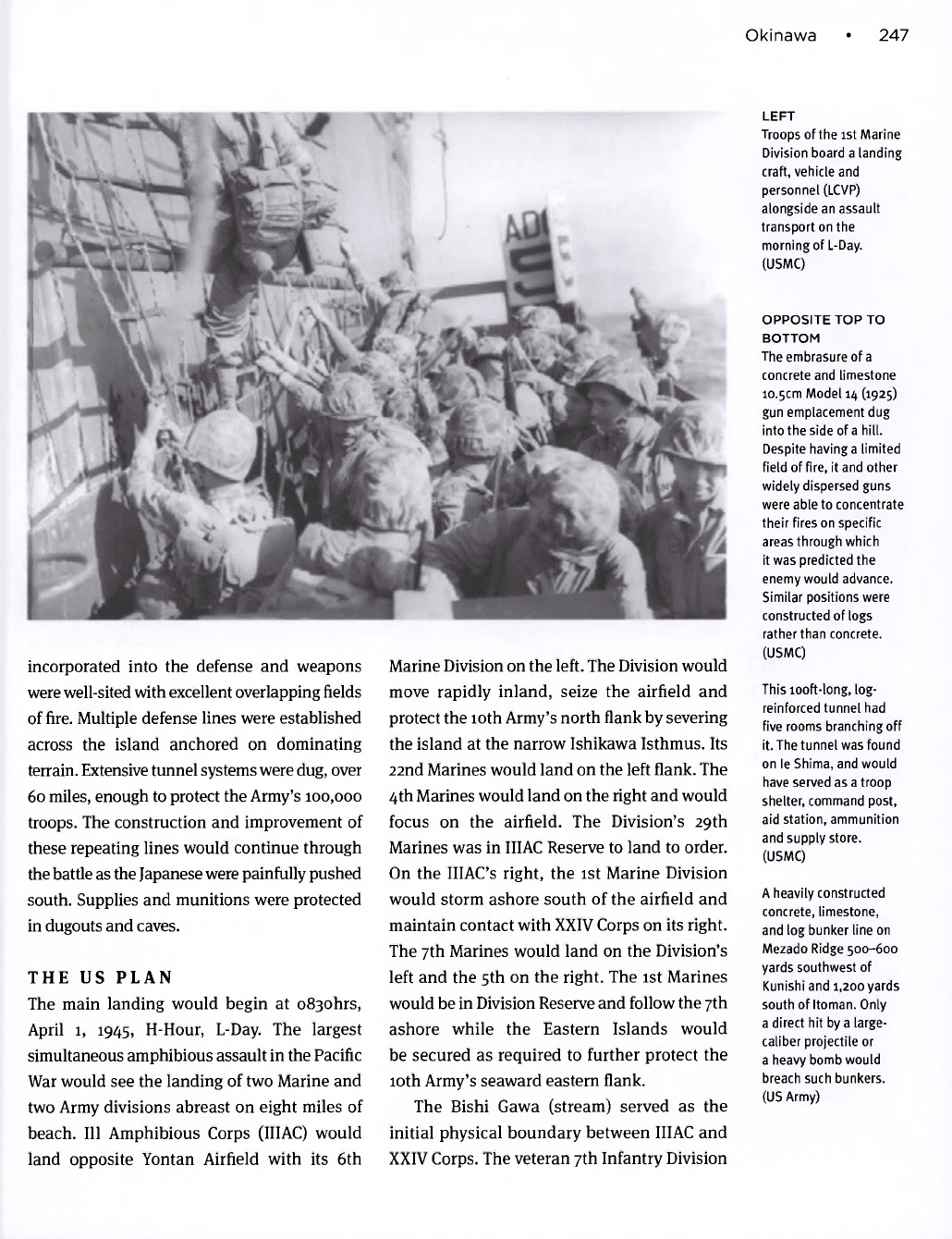
Okinawa • 247
incorporated into the defense and weapons
were well-sited with excellent overlapping fields
of fire. Multiple defense lines were established
across the island anchored on dominating
terrain. Extensive tunnel systems were dug, over
60 miles, enough to protect the Army's 100,000
troops. The construction and improvement of
these repeating lines would continue through
the battle as the Japanese were painfully pushed
south. Supplies and munitions were protected
in dugouts and caves.
THE US PLAN
The main landing would begin at o83ohrs,
April 1, 1945, H-Hour, L-Day. The largest
simultaneous amphibious assault in the Pacific
War would see the landing of two Marine and
two Army divisions abreast on eight miles of
beach. Ill Amphibious Corps (IIIAC) would
land opposite Yontan Airfield with its 6th
Marine Division on the left. The Division would
move rapidly inland, seize the airfield and
protect the 10th Army's north flank by severing
the island at the narrow Ishikawa Isthmus. Its
22nd Marines would land on the left flank. The
4th Marines would land on the right and would
focus on the airfield. The Division's 29th
Marines was in IIIAC Reserve to land to order.
On the IIIAC's right, the 1st Marine Division
would storm ashore south of the airfield and
maintain contact with XXIV Corps on its right.
The 7th Marines would land on the Division's
left and the 5th on the right. The 1st Marines
would be in Division Reserve and follow the 7th
ashore while the Eastern Islands would
be secured as required to further protect the
10th Army's seaward eastern flank.
The Bishi Gawa (stream) served as the
initial physical boundary between IIIAC and
XXIV Corps. The veteran 7th Infantry Division
LEFT
Troops of the 1st Marine
Division board a landing
craft, vehicle and
personnel (LCVP)
alongside an assault
transport on the
morning of L-Day.
(USMC)
OPPOSITE TOP TO
BOTTOM
The embrasure of a
concrete and limestone
10.5cm Model 14 (1925)
gun emplacement dug
into the side of a hill.
Despite having a limited
field of fire, it and other
widely dispersed guns
were able to concentrate
their fires on specific
areas through which
it was predicted the
enemy would advance.
Similar positions were
constructed of logs
rather than concrete.
(USMC)
This looft-long, log-
reinforced tunnel had
five rooms branching off
it. The tunnel was found
on le Shima, and would
have served as a troop
shelter, command post,
aid station, ammunition
and supply store.
(USMC)
A heavily constructed
concrete, limestone,
and log bunker line on
Mezado Ridge 500-600
yards southwest of
Kunishi and 1,200 yards
south of Itoman. Only
a direct hit by a large-
caliber projectile or
a heavy bomb would
breach such bunkers.
(US Army)
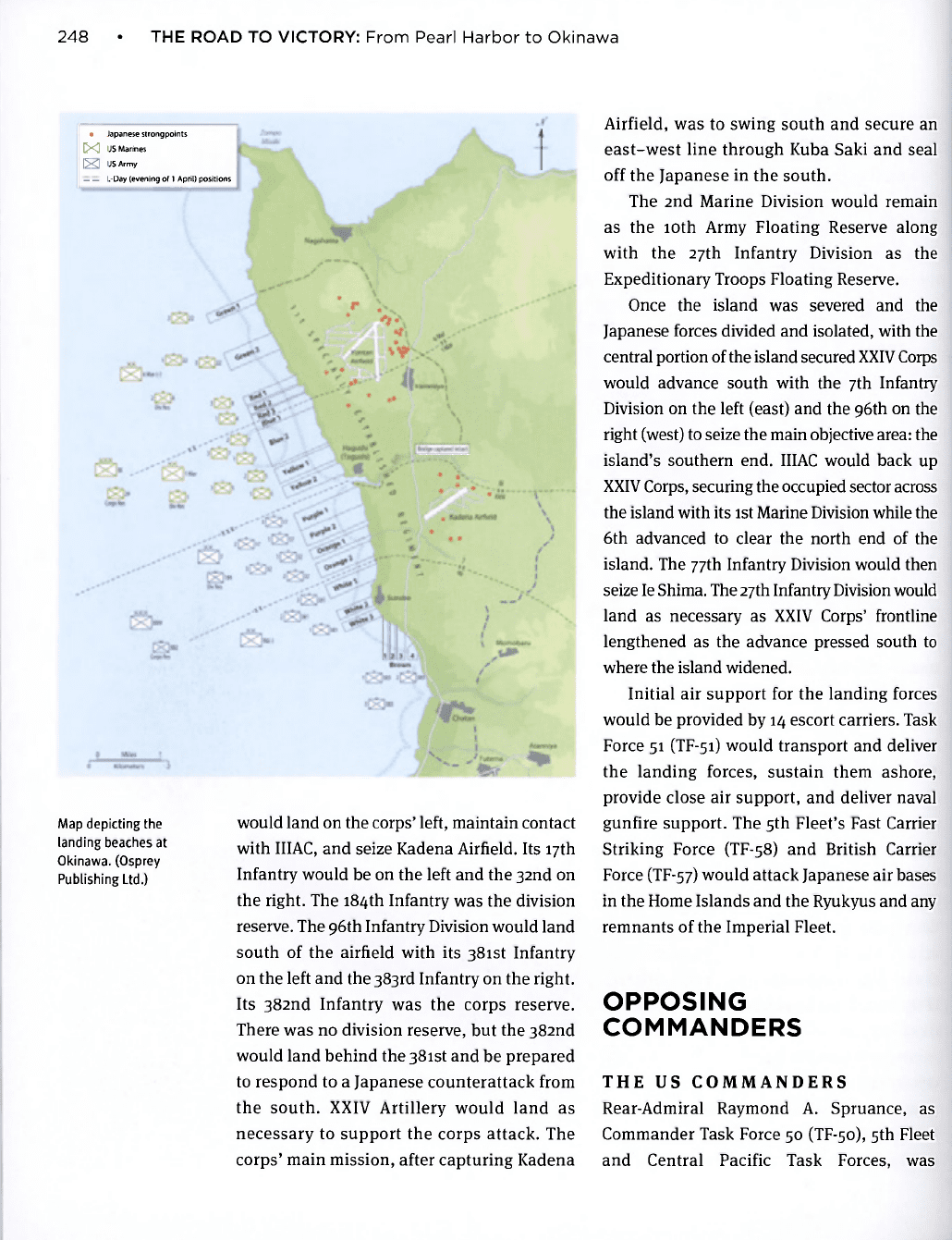
248 • THE ROAD TO VICTORY: From Pearl Harbor to Okinawa
• Japanese strongpoints
[><3 US Marines
153 US Army
— — 1-Day (evening of
1
April) positions
Map depicting the
landing beaches at
Okinawa. (Osprey
Publishing Ltd.)
would land on the corps' left, maintain contact
with IIIAC, and seize Kadena Airfield. Its 17th
Infantry would be on the left and the 32nd on
the right. The 184th Infantry was the division
reserve. The 96th Infantry Division would land
south of the airfield with its 381st Infantry
on the left and the 383rd Infantry on the right.
Its 382nd Infantry was the corps reserve.
There was no division reserve, but the 382nd
would land behind the 381st and be prepared
to respond to a Japanese counterattack from
the south. XXIV Artillery would land as
necessary to support the corps attack. The
corps' main mission, after capturing Kadena
Airfield, was to swing south and secure an
east-west line through Kuba Saki and seal
off the Japanese in the south.
The 2nd Marine Division would remain
as the 10th Army Floating Reserve along
with the 27th Infantry Division as the
Expeditionary Troops Floating Reserve.
Once the island was severed and the
Japanese forces divided and isolated, with the
central portion of
the
island secured XXIV Corps
would advance south with the 7th Infantry
Division on the left (east) and the 96th on the
right (west) to seize the main objective area: the
island's southern end. IIIAC would back up
XXIV Corps, securing the occupied sector across
the island with its 1st Marine Division while the
6th advanced to clear the north end of the
island. The 77th Infantry Division would then
seize Ie Shima. The 27th Infantry Division would
land as necessary as XXIV Corps' frontline
lengthened as the advance pressed south to
where the island widened.
Initial air support for the landing forces
would be provided by 14 escort carriers. Task
Force 51 (TF-51) would transport and deliver
the landing forces, sustain them ashore,
provide close air support, and deliver naval
gunfire support. The 5th Fleet's Fast Carrier
Striking Force (TF-58) and British Carrier
Force (TF-57) would attack Japanese air bases
in the Home Islands and the Ryukyus and any
remnants of the Imperial Fleet.
OPPOSING
COMMANDERS
THE US COMMANDERS
Rear-Admiral Raymond A. Spruance, as
Commander Task Force 50 (TF-50), 5th Fleet
and Central Pacific Task Forces, was
